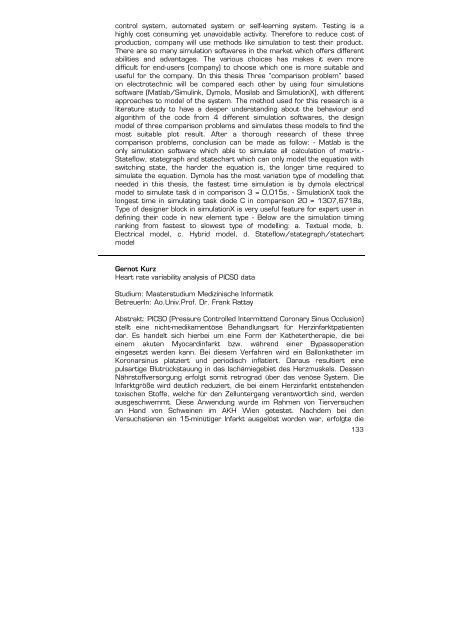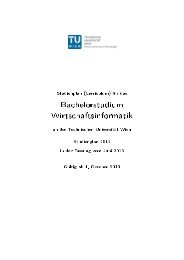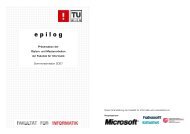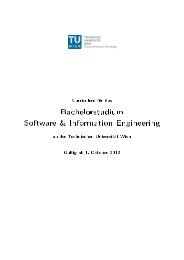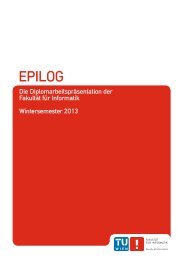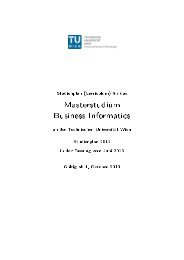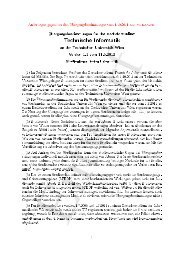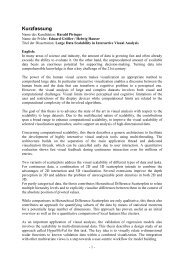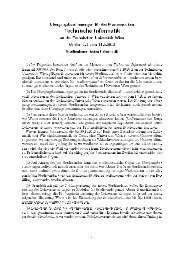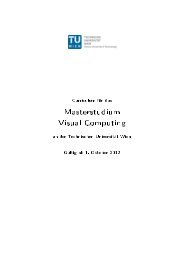e p i l o g - Fakultät für Informatik, TU Wien
e p i l o g - Fakultät für Informatik, TU Wien
e p i l o g - Fakultät für Informatik, TU Wien
Erfolgreiche ePaper selbst erstellen
Machen Sie aus Ihren PDF Publikationen ein blätterbares Flipbook mit unserer einzigartigen Google optimierten e-Paper Software.
control system, automated system or self-learning system. Testing is a<br />
highly cost consuming yet unavoidable activity. Therefore to reduce cost of<br />
production, company will use methods like simulation to test their product.<br />
There are so many simulation softwares in the market which offers different<br />
abilities and advantages. The various choices has makes it even more<br />
difficult for end-users (company) to choose which one is more suitable and<br />
useful for the company. On this thesis Three “comparison problem” based<br />
on electrotechnic will be compared each other by using four simulations<br />
software (Matlab/Simulink, Dymola, Mosilab and SimulationX), with different<br />
approaches to model of the system. The method used for this research is a<br />
literature study to have a deeper understanding about the behaviour and<br />
algorithm of the code from 4 different simulation softwares, the design<br />
model of three comparison problems and simulates these models to find the<br />
most suitable plot result. After a thorough research of these three<br />
comparison problems, conclusion can be made as follow: - Matlab is the<br />
only simulation software which able to simulate all calculation of matrix.-<br />
Stateflow, stategraph and statechart which can only model the equation with<br />
switching state, the harder the equation is, the longer time required to<br />
simulate the equation. Dymola has the most variation type of modelling that<br />
needed in this thesis, the fastest time simulation is by dymola electrical<br />
model to simulate task d in comparison 3 = 0,015s, - SimulationX took the<br />
longest time in simulating task diode C in comparison 20 = 1307,6718s,<br />
Type of designer block in simulationX is very useful feature for expert user in<br />
defining their code in new element type - Below are the simulation timing<br />
ranking from fastest to slowest type of modelling: a. Textual mode, b.<br />
Electrical model, c. Hybrid model, d. Stateflow/stategraph/statechart<br />
model<br />
Gernot Kurz<br />
Heart rate variability analysis of PICSO data<br />
Studium: Masterstudium Medizinische <strong>Informatik</strong><br />
BetreuerIn: Ao.Univ.Prof. Dr. Frank Rattay<br />
Abstrakt: PICSO (Pressure Controlled Intermittend Coronary Sinus Occlusion)<br />
stellt eine nicht-medikamentöse Behandlungsart <strong>für</strong> Herzinfarktpatienten<br />
dar. Es handelt sich hierbei um eine Form der Kathetertherapie, die bei<br />
einem akuten Myocardinfarkt bzw. während einer Bypassoperation<br />
eingesetzt werden kann. Bei diesem Verfahren wird ein Ballonkatheter im<br />
Koronarsinus platziert und periodisch inflatiert. Daraus resultiert eine<br />
pulsartige Blutrückstauung in das Ischämiegebiet des Herzmuskels. Dessen<br />
Nährstoffversorgung erfolgt somit retrograd über das venöse System. Die<br />
Infarktgröße wird deutlich reduziert, die bei einem Herzinfarkt entstehenden<br />
toxischen Stoffe, welche <strong>für</strong> den Zelluntergang verantwortlich sind, werden<br />
ausgeschwemmt. Diese Anwendung wurde im Rahmen von Tierversuchen<br />
an Hand von Schweinen im AKH <strong>Wien</strong> getestet. Nachdem bei den<br />
Versuchstieren ein 15-minütiger Infarkt ausgelöst worden war, erfolgte die<br />
133


